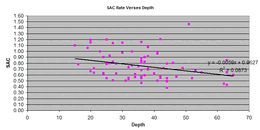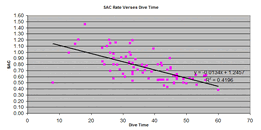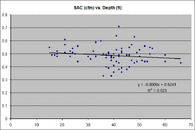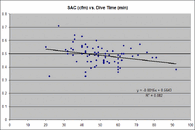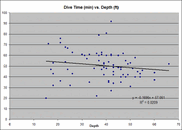Oh! I can't believe I forgot my big deal idea...
 Don't forget about temperatures!
Don't forget about temperatures!
I did a pair of 20-minute dives in a very cold quarry as part of a checkout. The first dive had a SAC through the roof (far greater than I'd predicted, given the conditions and my personal evaluation of myself while doing the dive), while the second dive had the SAC I'd expected. The dives were both to 20-25 feet deep, precisely 20 minutes long, on the same tank, doing the same wall dive. They were as identical as you could possibly make them, except that on the second dive, I kept getting entangled in the dive flag line, which made me significantly more stressed at several points. I didn't notice any chilling, although considering I hadn't left the water, it's only logical that chilling would've been on the second dive more than the first (and thus would have been working against the observed SAC discrepancy). So, why did the second, stressful dive have such a lower calculated SAC than the first very relaxing problem-free dive?
It hit me after thinking about it for a few moments. When I wrote down the starting pressure for the first dive, my cylinder was warm, having been in my car up until I geared up. By the end of the first dive, however, it was at the ambient temperature of the water in the quarry. The cooling of the cylinder and the air inside it effectively increased my apparent SAC for the dive. I spent the surface interval floating, and so for the second dive, the temperature in the cylinder was effectively a constant, giving me a valid non-inflated SAC. If you've ever seen an SPG drop a couple hundred PSI during a descent into a cold lake or spring on a hot day, it's not that you're breathing really hard or that you're using a lot of BC or drysuit gas -- it's simply the temperature dropping. (From "hot car in sun" 120°F to "cold lake" 50°F, an AL80 can lose something like 400 psi! [I think I punched that in right.

])
Anyway, so if you don't pre-cool your cylinders to the temperature of the water, your starting pressure will be artificially inflated. Over longer dives, that error is spread over a longer time, so your SAC isn't inflated as much. Since deeper dives tend to be longer, it follows that deeper dives would show less inflated SACs as well. It may not be that your actual air consumption is lower at all, just that you're not accounting for a significant source of systemic error.




